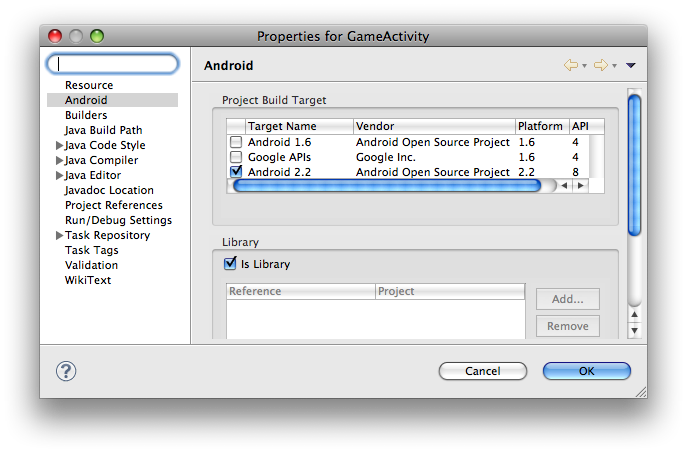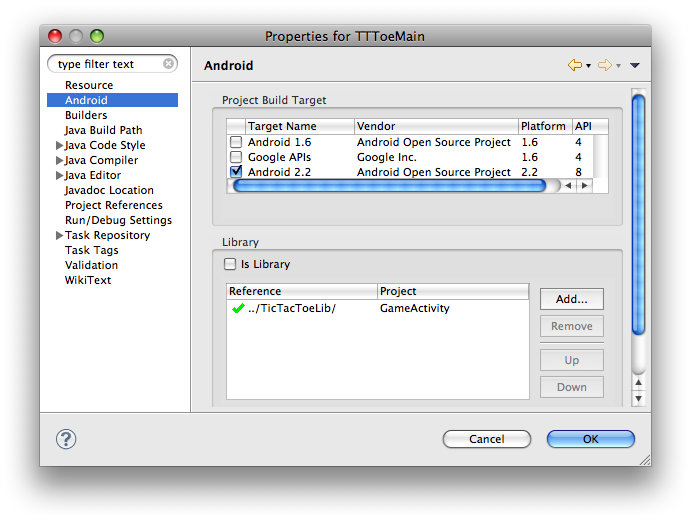Eclipse and the ADT plugin provide GUIs and wizards to create all three types of projects (Android project, Library project, and Test project):
The ADT plugin provides a New Project Wizard that you can use to quickly create a new Android project (or a project from existing code). To create a new project:
Select the lowest platform with which your application is compatible.
Note: You can change your the Build Target for your project at any time: Right-click the project in the Package Explorer, select Properties, select Android and then check the desired Project Target.
minSdkVersion attribute in the <uses-sdk> of your
Android Manifest file. If you're unsure of the appropriate API Level to use, copy the API Level
listed for the Build Target you selected in the Target tab.Tip: You can also start the New Project Wizard from the New icon in the toolbar.
A library project is a standard Android project, so you can create a new one in the same way as you would a new application project.
When you are creating the library project, you can select any application name, package, and set other fields as needed, as shown in figure 1.
Next, set the project's properties to indicate that it is a library project:
The new project is now marked as a library project. You can begin moving source code and resources into it, as described in the sections below.
You can also convert an existing application project into a library. To do so, simply open the Properties for the project and select the "is Library" checkbox. Other application projects can now reference the existing project as a library project.

Figure 1. Marking a project as an Android library project.
A library project's manifest file must declare all of the shared components that it includes, just as would a standard Android application. For more information, see the documentation for AndroidManifest.xml.
For example, the TicTacToeLib example library
project declares the Activity GameActivity:
<manifest>
...
<application>
...
<activity android:name="GameActivity" />
...
</application>
</manifest>
If you are developing an application and want to include the shared code or resources from a library project, you can do so easily by adding a reference to the library project in the application project's Properties.
To add a reference to a library project, follow these steps:
As soon as the Properties dialog closes, Eclipse rebuilds the project, including the contents of the library project.
Figure 2 shows the Properties dialog that lets you add library references and move them up and down in priority.

Figure 2. Adding a reference to a library project in the properties of an application project.
If you are adding references to multiple libraries, note that you can set their relative priority (and merge order) by selecting a library and using the Up and Down controls. The tools merge the referenced libraries with your application starting from lowest priority (bottom of the list) to highest (top of the list). If more than one library defines the same resource ID, the tools select the resource from the library with higher priority. The application itself has highest priority and its resources are always used in preference to identical resource IDs defined in libraries.
In the manifest file of the application project, you must add declarations of all components
that the application will use that are imported from a library project. For example, you must
declare any <activity>, <service>,
<receiver>, <provider>, and so on, as well as
<permission>, <uses-library>, and similar elements.
Declarations should reference the library components by their fully-qualified package names, where appropriate.
For example, the TicTacToeMain example
application declares the library Activity GameActivity like this:
<manifest>
...
<application>
...
<activity android:name="com.example.android.tictactoe.library.GameActivity" />
...
</application>
</manifest>
For more information about the manifest file, see the documentation for AndroidManifest.xml.